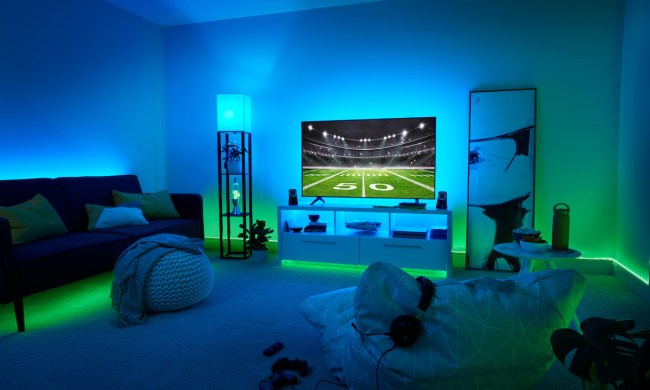Eleven-and-a-half-thousand athletes. A whopping 79,000 overseas officials, support staff, and amassed journalists. A total of 339 events in 33 sports, spread across 42 venues in Japan. Three hundred sixty-one days after it was originally scheduled to commence. These are a few of the significant big numbers when it comes to the delayed (somewhat confusingly called) 2020 Tokyo Olympics.
But, at least as far as the elite athletes involved are concerned, the most important numbers are the little ones. The really, really little ones. At the Olympics, countless hours of hard work on the part of the athletes comes down to milli- and microseconds.
While viewers might take for granted the numbers at the bottom of the TV screen measuring each lap or length, for those athletes who rely on them — and those engineers who have to ensure their accuracy — the technology is everything.
“It’s possible for us to measure one-millionth of a second,” Alain Zobrist, CEO of Omega Timing, told Digital Trends. “Margins that most disciplines don’t need, and will never use. In other words, what we are capable of in terms of accuracy is well above what’s expected of us.”
Quantum clocks and photofinisher
Luxury timepiece makers like Omega pride themselves on precision and accuracy. But, for the most part, it’s the precision and accuracy of technique. Not even James Bond, currently the world’s most famous wearer of Omega watches requires precision that measures in the millionths of a second. Even Q’s best exploding pen has the decency to have a timer measured in seconds.
The Olympic Games are different. Terms like “photo finish” were, quite literally, coined to describe sporting events in which the outcome is so close that hyper-accurate recording devices are essential.

Omega is no newcomer to the Olympics Games. It has been a fixture at almost every event since 1932 when state-of-the-art timekeeping meant deploying a watchmaker armed with 30 high-precision, but manually operated, stopwatches accurate to the nearest tenth of a second.
Today, the technology on offer — both quantitatively and qualitatively — dwarfs anything imagined back then. For this year’s Games, Omega-supplied clocks are synced up to an electronic starting pistol along with athletics starting blocks featuring sensors that measure an athlete’s force against the footrest an astonishing 4,000 times per second. The finish lines, meanwhile, are scoured by the Scan’O’Vision Myria, proclaimed by Omega to be its most sophisticated photo-finish camera in history; capable of recording up to 10,000 images per second.

The actual duration of the races is measured using a Quantum Timer, a form of atomic clock that uses laser-cooled single ions which are confined in an electromagnetic ion trap. The technology was first developed in 2010 by physicists at the U.S. National Institute of Standards and Technology, and was first utilized at the 2012 London Olympics in the form of the Quantum Timer and Quantum Aquatics Timer. These next-gen timers are driven by micro-crystal components embedded in the timer, which Omega says is 100 times greater than previous approaches.
Measuring what matters
But measurement is more than just who comes first, second, and third in a race. Omega is also entrusted to spot other phenomena, such as whether there has been a false start that might give an athlete a slight, almost imperceptible advantage over the competition.
“Our history is proof that we are getting better all the time,” Zobrist told Digital Trends. “However, I’d like to define ‘better’ a little more clearly, because it’s not just about trying to measure narrower time margins that we can boast about in a shallow way. We also think in terms of experience, for the athletes, the spectators, media, and even coaches. For instance, it makes more sense to accurately measure false starts than to record billionths of a second. Our timekeeping evolves to serve the athletes better, not just for the sake of it, so I don’t think we would waste too much energy on theoretical benchmarks.”
He continued that, “Of course we love to experiment and often push at the boundaries just to see how far we can go. But there is always something practical driving it.”
This focus on measuring performance as accurately and, importantly, rapidly as possible (no more waiting around for film to develop of photo finishes as took place in the days before instant video playback) means developing bespoke solutions for different sports.

For example, gymnastics uses A.I. pose detection that can be used to review how accurately an athlete hits the middle of a mat or their overall technique. Then there’s image recognition tech in swimming, for counting the number of strokes each athlete takes and measuring metrics like live speed and the exact distance between swimmers. Measuring road and track cycling? Motion sensor tags placed on the bikes. Beach volleyball? Image-tracking cameras to measure the speed of the players and the ball. And so on and so forth: Omega being called on to time not just the winner, but also to track as many factors about the winning (and losing) performances as possible.
“Almost all of [our research and development] takes place in a small village in Switzerland not far from the brand’s HQ in Biel/Bienne,” said Zobrist. “However, we also get great ideas when we’re at the events. The Olympic Games is an amazing learning experience. We are constantly monitoring our performance and discussing how we can make something simpler to use, more secure, more engaging visually. The R&D process never ends. It’s woven into what we do. So we tinker in the workshop, and learn out in the field.”


